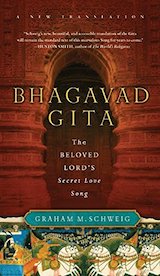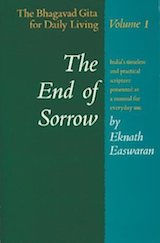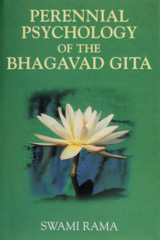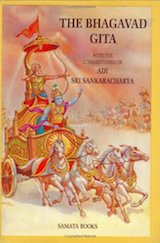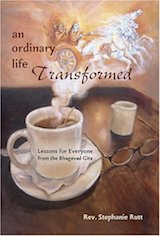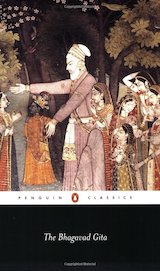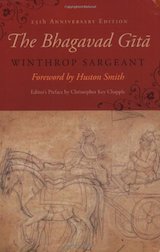The Bhagavad Gita (“Song of the Lord”) is a spiritual masterwork—a luminous discourse on philosophy, psychology, and the practical aims of everyday life. Written over two millennia ago, the Gita—a portion of a much larger epic, the Mahabharata—was first translated into English in 1785. The Gita records a dialogue between Lord Krishna, the voice of the Infinite, and his devoted student, Arjuna. Over a span of 700 verses, Krishna quiets Arjuna’s painful doubts about the role he must play in the onset of a catastrophic war.
A Wisdom Teaching
Krishna’s advice to Arjuna is a source of wisdom and spiritual support. But the Gita’s 18 chapters also raise challenging questions. To begin, while the Gita is a book about yoga, it is framed by an epic story of conflict and war. Some (including Mahatma Gandhi) wish that the Gita’s teachings had given less attention to the historical theme of war and had focused more on the allegorical principle of non-violence. Readers of the Gita must grapple with the same quandary that Arjuna is dealing with: How are we to transcend violence in the midst of violent times?
While the Gita appears focused on Arjuna’s question, “Shall I fight?” its account of the conflict between sets of royal cousins lifts its readers well above the confines of power politics. The Gita towers over limited viewpoints and petty disputes. It raises questions about the permanence of existence; outlines the structure of the human mind; supports the practice of meditation; and presents four essential paths (jnana, bhakti, kriya, and raja yoga) for living an enlightened life.

How to Approach the Gita
This series of blog posts is an attempt to actively engage with the Gita in both large and small ways. For instance, the Gita offers definitions of yoga that are unfamiliar to many readers. Assertions such as “yoga is equanimity” and “yoga is skillfulness in action” may puzzle Western students whose focus centers primarily on postures or breathing exercises. This is one of the reasons that it is important to find a commentary to read along with the original text.
The Gita raises questions about the permanence of existence.
Comparing translations of the Gita is a good way to engage with it. At the end of this post, you’ll find a list of various editions of the Gita. If you don’t own a copy yet, this booklist will help you choose one or two for your bookshelf. In the next post, we’ll explore differences in the translation of just one verse—verse 7 of chapter 2. You will be able to compare your version of the Gita with a number of others. For now, if you would like an assignment, read chapter 1 through chapter 2, verse 10. That will get us started on reading the whole text.
On a larger scale, as we have glimpsed above, the Gita gives attention to a number of important themes. Krishna’s effort to relieve Arjuna’s depression is one of them. Is it possible that the report Arjuna gives of his symptoms, coupled with an account of Krishna’s counseling, might offer hope and help to readers going through similar distress?
Start with Pronunciation
At the moment in which we join Arjuna on the battlefield, the impending war involves all the great armies, generals, and kings of his time. Gazing across at both armies, Arjuna foresees nothing but destruction and loss, the consequence of battles between warriors of virtually unsurpassed skill. Chapter 1 opens with the naming of many of these legendary generals arrayed on either side of the battlefield. But this list of long, unfamiliar, and difficult-to-pronounce names frequently brings Western readers to a halt. The solution:
- Unless you are intent on building pronunciation skills, let most Sanskrit words pass by and simply focus on pronouncing Arjuna’s name correctly: Arjuna = AR-ju-na
- The first syllable receives a mild accent. Pronounce it as in the English word car. It lasts about twice as long as ju and na, which are both short sounds. Pronounce ju as in jute. Pronounce na as in nut.
- Don’t be concerned with any of the other generals’ names. With few exceptions, you won’t see them again in the Gita.
- Epithets for Arjuna and Krishna do appear throughout the text. You may enjoy learning the pronunciation and rich meaning of these epithets at some point, but for now you need not be concerned with them. Just two names will suffice: Arjuna and Krishna.

Arjuna’s Pain
The pain to be resolved in the Gita is ultimately the result of Arjuna’s deep-seated attachments. His love for his teachers, his affection for those fighting on both sides of the conflict, the desire he cherishes to protect social order, and even the sympathy he feels for his evil cousins—all confound him. His is a personal torment, an affliction with roots largely invisible even to himself. The pain of Arjuna’s inner struggle appears to be an isolating experience—a despair that most of us understand. Asking Krishna, his charioteer, to bring his chariot into the middle of the battleground, Arjuna reveals his deep inner struggles to Krishna. He mourns:
- My limbs are frozen, my mouth is drying up, my body trembles, and my hair stands on end . . . My mind is, as it were, whirling (BG 1:29 –30).
- I do not desire victory, nor kingdom, nor comforts (BG 1:32).
- Teachers, fatherlike figures, sons, uncles, and other relatives . . . I do not wish to kill them, even if they are killing me (BG 1:34–35).
- How can we be happy after killing our very own relatives (BG 1:37)?
- Oh, alas, we are embarking upon committing a great sin as we are preparing to kill our own kinsmen out of greed for kingdom and comfort (BG 1:45).
- If the sons of Dhritarashtra, with weapons in hand, kill me in the battle while I am unarmed and unavenging, that will be more beneficial to me (BG 1:46).
These speeches, all selected from chapter 1, illustrate the depth of Arjuna’s depression. He is confused: Is he battling his cousins out of greed and a desire for power? Or is he stimulated by less selfish motives, intentions momentarily veiled by images of destruction? A depressive triad—helpless, hopeless, hapless—is clearly visible in Arjuna’s turn toward darkness. Worse, disregarding Krishna’s advice, Arjuna continues to struggle with his mood, finally arriving at a pivotal point. In chapter 2, verse 7, Arjuna utters words that take us to the core of the Gita: “My true nature subdued . . . my mind deluded . . . I am your disciple surrendering to you. Do teach me and guide me.” With these words, Arjuna appeals to Krishna from a place of openness and surrender. He asks for advice and for help in making peace with his actions in the world. How will Krishna respond, and what will happen to Arjuna? We’ll find out in the next post in this series.
Further Reading
The Gita in Print
The Bhagavad Gita has been printed in many editions and languages. Here are some practical suggestions to help you choose a text or to expand your Gita library.
A Clear English Translation
Best Contemporary Commentaries
Traditional Philosophical Commentary
Practical Application
Spiritually Inspiring
For the Sanskrit Student

